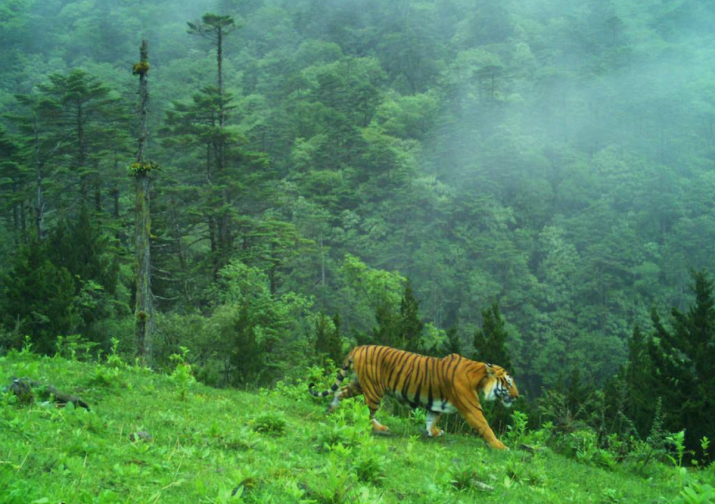
New research published by the Global Tiger Forum (GTF), an international, inter-governmental body working for the conservation of tigers in the wild, has identified high-altitude Himalayan regions extending across Bhutan, India, and Nepal that could represent viable conservation habitats for tigers, noting that evidence of populations of the endangered cats has been logged in these regions.
The recently published study, titled Status of Tiger Habitats in High Altitude Ecosystems of Bhutan, India and Nepal (Situation Analysis) 2019, identifies “habitat suitability for tigers across two distinct Himalayan zones, Eastern and Western Himalayas.” (Mongabay) Territories highlighted by the research include the Indian states of Uttarakhand, Sikkim, northern West Bengal, and Arunachal Pradesh, in addition to high-altitude areas of Bhutan and Nepal.
“This situation analysis is a snapshot. We really need to intensify our effort and we need to answer some questions that are raised in this report,” Global Tiger Forum secretary-general Rajesh Gopal explained. “A deep study would help us to know whether the tigers in the high-altitude areas are tigers from a source which are at a high altitude, or they have gone there owing to some compulsions from the source areas at the foothills through linkages which are equally disturbed, or whether they went up following the pastoral groups.” (Mongabay)
The report also emphasized that high-altitude tiger habitats that overlap with human settlements require protection through sustainable land use as they are high-value ecosystems that could help to mitigate the effects of climate change.
Led by the New Delhi-based Global Tiger Forum, the study was carried out in cooperation with the governments of Bhutan, India, and Nepal, and conservation organizations such as the World Wide Fund for Nature (WWF), and the Integrated Tiger Habitat Conservation Program of the International Union for Conservation of Nature (IUCN). The research team studied secondary data, interviewed local communities, and employed camera traps to monitor the presence and movements of tigers at elevations in excess of 4,000 meters above sea level.
“We now have concrete evidence that tigers are present in high altitude areas of all four states,” said Nishant Verma, deputy inspector general of India’s National Tiger Conservation Authority (NTCA). “The study was to understand tiger presence in high altitude regions of Nepal, Bhutan, and India. In all three regions tigers are there in the higher reaches. We are not sure if they reside there or are moving from other places. That will be verified in the second part of our study,” (Hindustan Times)

The researchers installed more than 200 camera traps in high-altitude regions of the three countries, recording tiger movements at 4,038 meters in Bhutan and at 3,602 meters in India. It identified potentially viable habitats totaling 52,671 square kilometers, from 11,543 square kilometers in Bhutan, 38,915 square kilometers in India, and 2,213 square kilometers in Nepal.
Tiger habitats encompass a wide variety of environments, including mangrove swamps, plains, rainforests, arid and semi-arid areas, and mountainous regions, however, to date, very few high-altitude zones have been surveyed for tiger presence, prey, and habitat status.
“The instant situation analysis study provides the rationale for stepping up high altitude conservation of the tiger, while identifying possible viable habitats, corridor linkages, anthropogenic pressures, and induced landscape level changes for evolving an in-situ conservation roadmap,” India’s Ministry of Environment, Forest and Climate Change said in a statement on 3 September. (Hindustan Times)
“This provides the action strategy for a high altitude tiger master plan, with gainful portfolio for local communities and ensuring centrality of tiger conservation in development, through an effective coordination mechanism, involving stakeholders and line departments operating within the landscape.” (Hindustan Times)
Census data published in July indicated that India’s population of wild tigers had risen by 30 per cent in the preceding four years to a total of 2,967 tigers. India’s lowest-recorded figure was 1,411 tigers in 2006. A survey in 2013 indicated that Nepal had an estimated tiger population of 163–235 breeding adults, while in 2015, the wild tiger population in Bhutan was estimated at 103 individuals.
The global population of tigers living in the wild fell to a record low of some 3,200 in 2010, down from an estimated 100,000 in 1900. As of 2015, the global wild tiger population was estimated to be between 3,062 and 3,948 mature individuals. In 2010, India and 12 other countries inked an agreement to pursue initiatives to double their wild tiger populations by 2022.
See more
Status of Tiger Habitats in High Altitude Ecosystems of Bhutan, India and Nepal (Situation Analysis) 2019 (Global Tiger Forum)
Global Tiger Forum
Global Tiger Forum (Facebook)
Global Tiger Forum (Twitter)
Can the upper Himalayas be the new home for tigers in South Asia? (Mongabay)
Master Plan for High Altitude Tigers on the Anvil: Envt. Min (The Weather Channel)
Tigers present in high altitudes in four states, says NTCA in report (Hindustan Times)
India’s tiger population jumps to almost 3,000: census (Al Jazeera)












